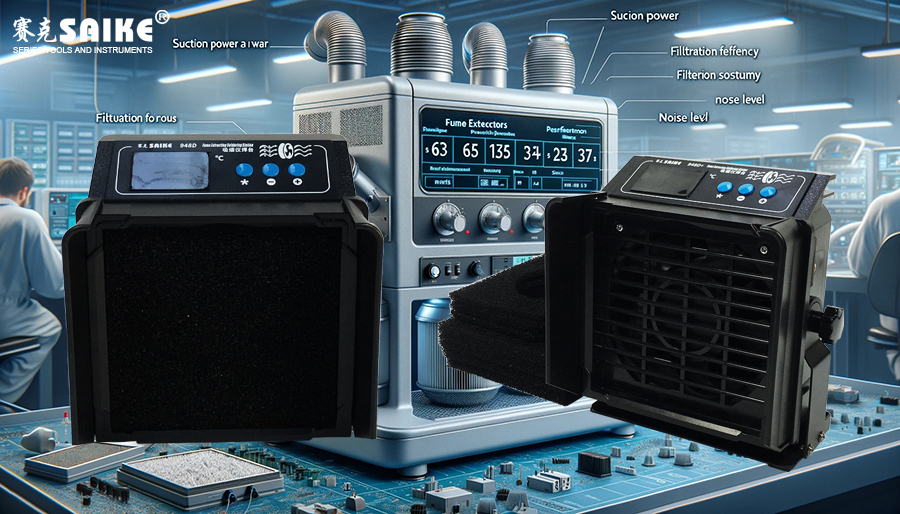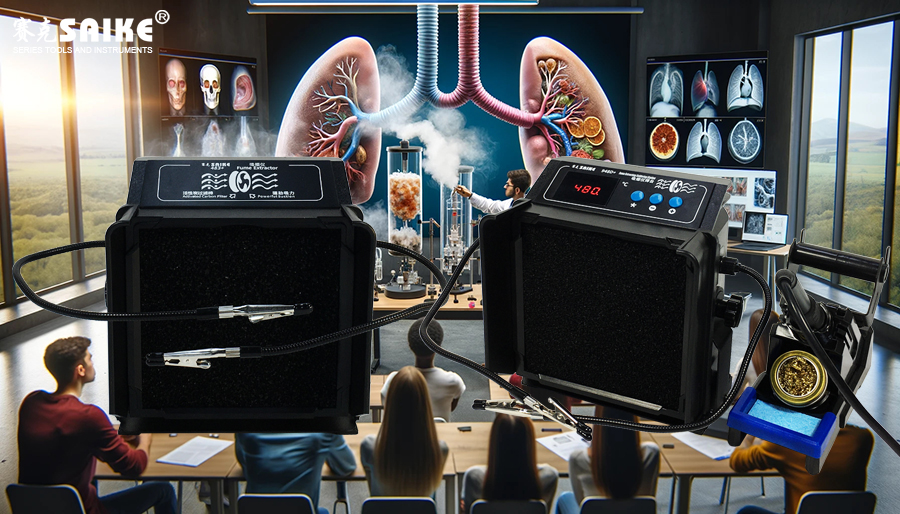
SK-YJ000XYY-KP 100005
I. Performance Parameters
1.Suction Power and Airflow
– Definition: Suction power refers to the maximum negative pressure that a fume extractor can generate, usually expressed in Pa (Pascal) or mbar (millibar). Airflow refers to the volume of air passing through the device per unit of time, typically measured in CFM (cubic feet per minute) or m³/h (cubic meters per hour).
– Importance: Suction power and airflow are core indicators for evaluating the performance of a fume extractor, determining its ability to absorb and process smoke.
2.Filtration Efficiency
– Definition: Filtration efficiency refers to the percentage of particulate matter that a fume extractor can remove from the air, usually expressed as a percentage.
– Standard: HEPA filters typically achieve a filtration efficiency of 99.97%, capturing particles 0.3 microns and larger.
3.Noise Level
– Definition: The sound level generated during operation, measured in dB (decibels).
– Impact: Noise level has a direct impact on the comfort of the working environment, especially in laboratories or offices where a quiet environment is required.
II. Technical Specifications
1.Size and Weight
– Size: Includes the height, width, and depth of the fume extractor, affecting the placement and spatial layout of the equipment.
– Weight: Affects the mobility of the equipment and the choice of installation location.
2.Power Requirements
– Voltage and Frequency: Usually need to consider the power adapter of the equipment, such as 110V, 220V, etc., as well as the frequency of 50Hz or 60Hz.
– Power Consumption: Indicates the energy demand during normal operation, affecting long-term operating costs.
3.Filtration System Type
– Filter Types: Generally include coarse, medium, and high-efficiency HEPA filters and activated carbon filters.
– Replacement Cycle: Refers to the recommended replacement time or service life of the filter. It is important to replace the filter in a timely manner according to actual usage to maintain optimal performance.
4.Interface and Control
– User Interface: May include a digital display screen, touchscreen, or physical buttons.
– Control Options: Include fan speed adjustment, automatic mode, timer, etc., to adapt to different usage needs and environments.
5.Safety Certification
– Standards: Such as CE, FCC, RoHS, etc. These certification standards indicate that the equipment meets international safety and environmental protection standards.
III. Conclusion
Understanding the performance parameters and technical specifications of a fume extractor is crucial when making a selection. This not only helps users choose products that meet their actual needs but also ensures the effective operation and long-term stability of the equipment. Reasonable performance configuration and technical specifications that meet the demand can bring users a more efficient, safe, and economical experience. Before purchasing, it is recommended that users have an in-depth discussion with the manufacturer or sales representative to ensure that they select the most suitable fume extractor for their application environment.


